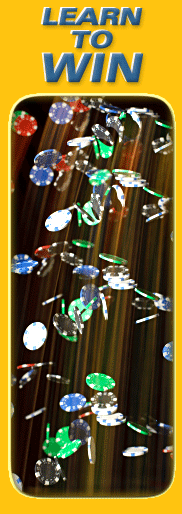House Edge: Casino Games
by Frank Scoblete
The house edge is one of two major factors that must be considered when approaching casino games and individual bets and strategies at those games. The other is speed or number of decisions per hour that is discussed in the next lesson.
The first goal of all good gamblers is to cut the house edge to a minimum on the games you like to play. If you are just deciding which games to play, then you should first look at the games where the casino edge can be kept under 2 percent. This dictum holds true for table games and for all machine games as well.
What is the house edge exactly? The definition usually goes something like this: “The house edge is the percent of all the money wagered at a game that the house can expect to keep in the long run.” Does it mean the house wins more decisions?
Well, yes, in part that is true. Take a game such as craps.
One of the very best bets at that game is the Pass Line bet. In 495 Pass Line bets, the house will win 251 and the player will win 244. Since the bet pays off at even money, (you bet $5 and, if you win, you win $5), that seven win shortfall for the player translates into a casino edge of approximately 1.41 percent. Okay, what does that mean in terms of money won or lost?
If you look at a $100 wagered, you can safely say that in the long run a player will lose approximately $1.41 for every $100 he bets on the Pass Line.
So the house edge is developed by winning more decisions.
Yet, at blackjack, the casino wins a lot more decisions than the player does, approximately 4 more decisions for every 100 decisions. Does that mean the casino edge on blackjack is in the stratosphere? No, it doesn’t.
First, blackjacks pay 3 to 2 and you get a blackjack about five times for every 100 hands and, if you play your cards right, (play basic strategy--the computer derived best play of every player hand against every dealer upcard) you will increase your chances to win. When all is said and done, a wise blackjack player is putting more money into the mix when doing so favors him and he is putting less money into the mix when the house is favored.
So, despite the fact that the house wins so many more decisions, the savvy blackjack player makes up for it in the amount of money he wins on the player-favorable decisions. A good blackjack player faces about a one-half percent edge in most games.
That translates into a 50-cent loss for every $100 wagered at the game – a close contest, indeed.
However, in some situations the house makes its money by charging the winning wager a tax, variously called the “vig” or “vigorish.”
Let us take roulette as an example. If you bet a single inside number on the American double-zero wheel, you can expect to win one time out of 38 tries. The odds of the bet are therefore 37 to one.
In a fair game on a $1 wager, you would win $37 for the one time Lady Luck smiled, but lose $37 on the times when she ignored you.
The casino can’t make a profit by breaking even at its games.
So instead of paying you $37 for a win, the casino only pays you $35. It keeps the other $2 for itself! In essence, when you win the casino becomes your partner!
How does the tax compute into a house edge? You just divide 38 (the number of decisions) into the $2 the house keep for itself and you get a house edge of 5.26 percent. Yes, you can expect to lose $5.26 for every $100 wagered at roulette – that’s over 10 times more than what you can expect to lose at blackjack and five times more than what you can expect to lose betting the Pass Line in craps.
On most table casino games, you will see a mixture of “winning more decisions” and “taxing wins” as the means for establishing a house edge. Sometimes you will see both methods employed on different bets at the same game.
In roulette, the inside numbers are taxed; the outside even-money bets have the house winning more decisions.
In craps, the Pass, Don’t Pass, Come, Don’t Come, and Field will have more winning house wagers, while the hardways, and other crazy crapper proposition bets will levy a high tax on winning wagers.
Slot machines and video poker machines are programmed to return less money than is put in them. If a machine is programmed to return 95 percent, which means for every $100 bet in the long run at that game, you can expect to lose $5 – yes a 95 percent return is the same as a 5 percent house edge!
Now it would be dull if the machines returned their 95 percent smoothly; that is, you put in $100 and you get back $95; you put in $100 and you get back $95 – ad infinitum. You might as well play the change machine as a $100 “wager” in them will return $100.
To make slot and video poker play alluring and exciting, the returns are done explosively. You can go for several, many or most spins (decisions) without hitting a single winning combination and then, bam!, you get a hefty sized win – maybe a huge win, enough to put you into scream mode!
Still, over a sufficiently long period of time, when you look at all the money you put through the machine, you will find that the house had close to its edge on you. The only exceptions would be the 1 in 50 million chance Megabucks winners or the like, who hit life-altering jackpots. The total amount wagered by all the players will come in at the house edge in the long run, life altering jackpots or not.
Finally, all house edges are done in math and are theoretical. In the real world, they are only realized when the casino or player hits the long run. And how long is the long run? It’s very long for a player; and not so long for a casino!
Suffice it to say that the long run is usually millions upon millions of decisions – all of which I intend to be around for!
From house edge, we move on to game speed and decisions
OR
Return to Gambling Tips and Strategies
Gambling Teachers home
GT is attentive about getting the word out about our free programs, lessons and add-ons offered, however, we ask your assistance and consideration in promoting us.
Click link below that reads, "Enjoy this page? Please pay it forward. Here's how..." to add a link to your site, blog or personal page.
Tips, Terms & Wins
Reserve best room rate, play your card for a few hours/day at that casino and charge all items including meals and gifts to your room.
Then, visit the club host near the end of trip and request a comp for entire stay.





